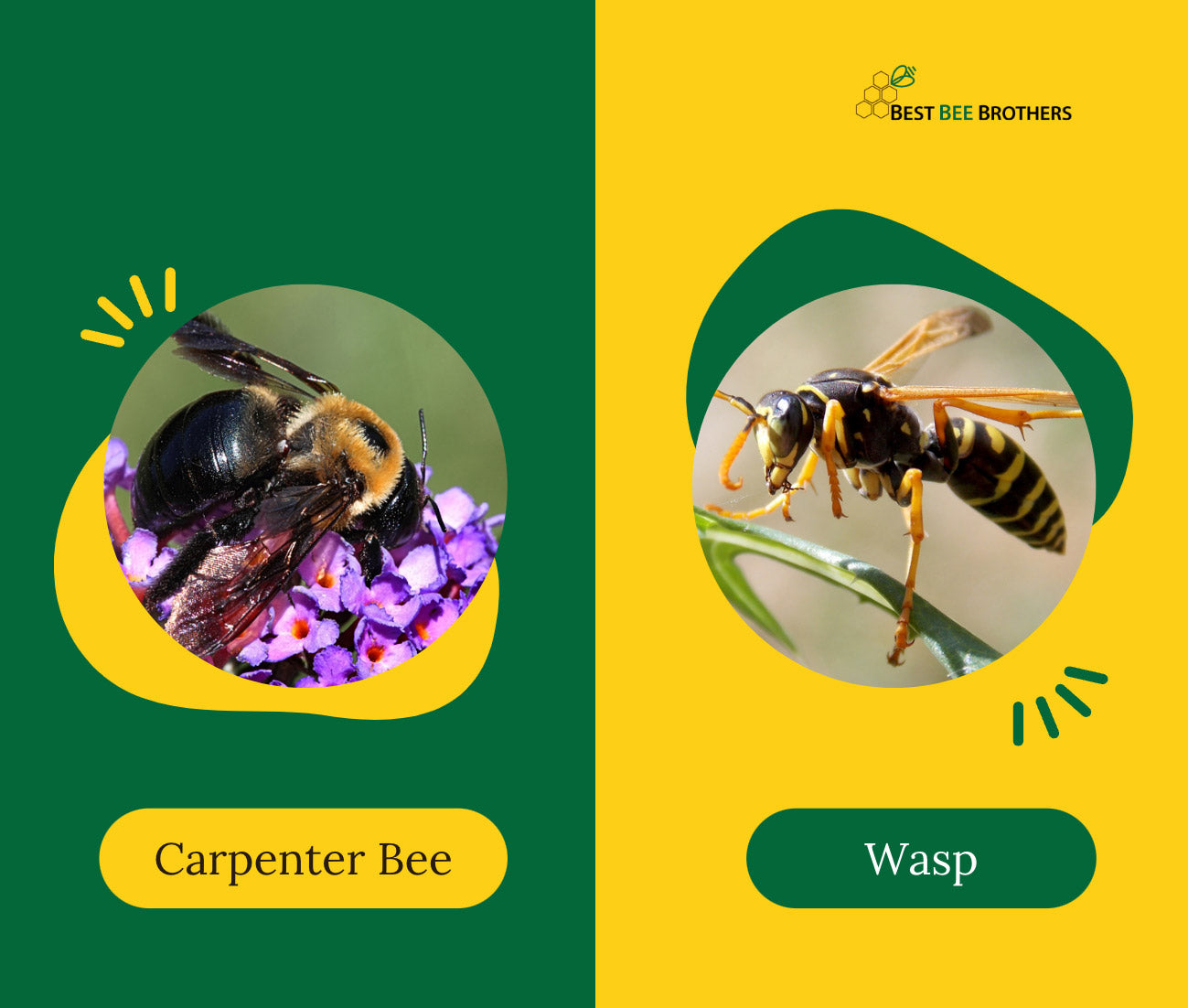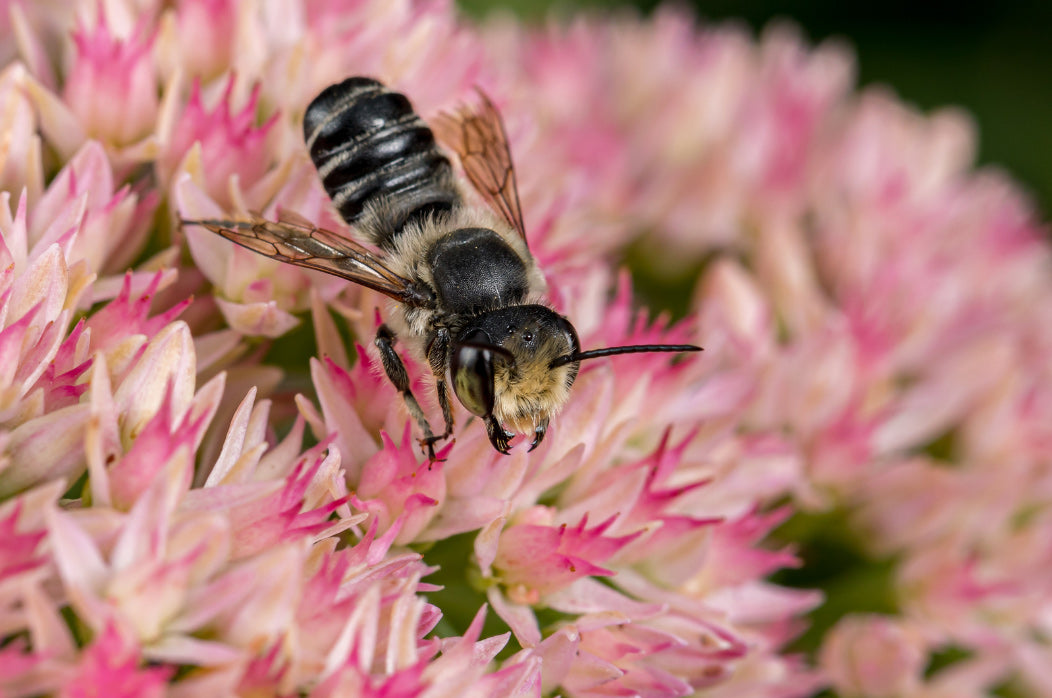If you have problems with carpenter bees or wasps – maybe both! – you may be wondering whether carpenter bee traps can help with a wasp issue or vice versa. In this article, we’ll discuss the importance of using different traps to manage these two very different insect populations. We’ll also cover how a few of our specially designed products can help you tackle both problems head-on!

Controlling the populations of carpenter bees and wasps around your home is of utmost importance because of the problems they can cause if left unchecked. Carpenter bees, with their drilling and nesting habits, can wreak havoc on wooden structures, including log homes or wooden siding. As they bore into wood to create nesting structures, they leave unsightly holes and tunnels that over time can lead to extensive damage and expensive repairs.
Similarly, wasps can be a cause for concern due to their aggressive behavior and painful stings. Whether you’re hosting outdoor gatherings, tending to your garden or simply enjoying all that your outdoor space has to offer, the presence of wasps can quickly turn these activities into uncomfortable and potentially dangerous situations. For individuals who are hypersensitive or allergic to wasp stings, the consequences can be even more severe, requiring immediate medical attention.
At Best Bee Brothers, we have developed a range of carpenter bee and wasp traps that are specifically designed to address the nesting and stinging habits of carpenter bees and wasps, targeting these insects without harmful chemicals or a negative impact on other, beneficial bugs and friendly pollinators. Our traps are meticulously crafted with high-quality materials and innovative designs, ensuring their effectiveness and longevity.
Carpenter Bee Traps
Carpenter bee traps are an essential tool for effectively managing these wood-boring insects. Understanding how they work can help you make the most of their unique qualities and allow for greater protection of your home.
After studying the behavior of these insects in the wild, we designed our carpenter bee traps based on field-tested strategies that have proven extremely effective in capturing these troublesome bees.

Understanding Carpenter Bee Behavior and Habitats
Before we get into how our carpenter bee traps work, it’s important to take a moment to familiarize yourself with carpenter bee behavior. This way, you can implement targeted measures and place traps strategically to maximize their effectiveness around your home. Let’s delve into some key aspects of carpenter bee behavior and habitats:
- Nesting Behavior: Carpenter bees are known for their drilling and nesting in wooden structures. Female carpenter bees create tunnels by burrowing into unpainted or untreated wood, such as eaves, siding, fascia boards, window trim, decks, railings and outdoor furniture. These tunnels serve as their nesting sites, where the females lay eggs and rear their offspring. Male carpenter bees, on the other hand, are more territorial and can exhibit aggressive behavior but lack stingers.
- Wood Preferences: Carpenter bees are particular about where they nest, preferring softwoods that are easier to bore into, such as pine, cedar, redwood and cypress.
- Seasonal Activity: Carpenter bees are active during the spring and summer months when temperatures rise, though in some regions, their season stretches into the fall. They emerge from their overwintering sites, mate and then begin constructing their nests. Female carpenter bees create new tunnels, while male carpenter bees patrol the nesting areas to protect their territory. Understanding the seasonal patterns of carpenter bee activity can help you time your control efforts effectively.
- Nest Defense: Similar to other bees, carpenter bees can exhibit defensive behaviors if they feel their nest or territory is being threatened. Male carpenter bees, despite lacking stingers, can be territorial and may dive-bomb or hover near intruders to protect their nesting areas. Female carpenter bees, while capable of stinging, are not typically aggressive unless provoked.
Placing carpenter bee traps strategically near the bees’1 nesting sites or areas of activity can help capture them and control their population. Additionally, implementing preventive measures, such as painting or sealing wooden surfaces, can also deter carpenter bees from selecting your home as a nesting site.
How Do Best Bee Brothers Carpenter Bee Traps Work?
Visual cues play a significant role in the effectiveness of our carpenter bee traps. The traps are made of soft, untreated pine wood, which carpenter bees prefer.
To jump-start your trap, we also offer our proprietary BEE-Licious Bee Bait. This scent is a powerful attractant, further compelling the bees to enter the trap. This is because carpenter bees are somewhat opportunistic creatures; they’d much rather inhabit an old carpenter bee nest than tunnel a new one themselves.
Because of this species-specific design, our traps are effective at targeting and capturing carpenter bees without affecting other beneficial pollinators, such as bumblebees and honeybees.
To maximize the effectiveness of our carpenter bee traps, consider the following tips:
- Placement: Proper trap placement is crucial. We recommend that you position the trap near the areas where carpenter bees are most active, such as up high on wooden structures, decks or eaves. By strategically placing the trap in their flight path, you increase the chances of attracting and capturing them. If you’ve already noticed carpenter bees in your area, take note of the locations. These spots are ideal for trap placement.
- Maintenance: Regular maintenance is essential to keep your carpenter bee trap functioning optimally. Inspect the trap periodically and remove any captured bees. Cleaning the trap with mild soap and water helps remove debris and ensures its continued functionality. Additionally, replace the BEE-Licious Bee Bait when it dries out or has been washed away, as a fresh attractant will enhance the trap’s effectiveness. Retaining a bee or two in your bee trap also helps attract bees.
- Patience and Persistence: Managing carpenter bees requires patience and persistence. It may take some time for the bees in your area to become familiar with the trap. We recommend monitoring it regularly and making adjustments as needed to optimize its performance. Additionally, adding a second or third trap in different areas around your home can significantly increase the traps’ overall coverage and protection. And try our seasonal prevention tips to help you make the most of your trap.
Wasp Traps
Wasps are highly adaptive insects known for their aggressive nature and diverse nesting behaviors. They can build nests in various locations, including trees, eaves and even underground.
While wasps play a role in the ecosystem as pollinators and predators of other insects,2 their nesting around humans can lead to potentially dangerous situations. Help reduce the risk of painful encounters and enjoy a more peaceful outdoor space with a wasp trap.
Understanding Wasp Behavior and Habitats
To manage wasp populations and implement targeted control measures, it is crucial to have an understanding of their behavior and preferred habitats. This knowledge allows you to take preventive actions to minimize their presence near your home. Let’s explore some key aspects of wasp behavior and habitats:
- Nesting Behavior: Wasps exhibit diverse nesting behaviors depending on the species. Some common types of wasp nests include paper wasp nests, mud dauber nests and ground-nesting wasp burrows. Paper wasps construct their nests from a paper-like substance made by chewing wood fibers mixed with saliva3. Mud daubers build tubelike nests using mud, often attaching them to walls or other structures. Ground-nesting wasps create nests in burrows excavated in soil.
- Food Preferences: Wasps are omnivorous insects. They are attracted to sources of protein, such as other insects, caterpillars (the larvae of other insects) and spiders, which they feed to their own, developing larvae. Wasps are also foragers that will feed on food scraps. Many wasp species are known to have a sweet tooth and are attracted to sugary substances, including nectar, ripe fruits and sweet beverages4.
- Nest Defense: Wasps are protective of their nests and can become aggressive when they perceive a threat. Disturbing a wasp nest or approaching it too closely can trigger defensive behaviors, resulting in stings. It is crucial to exercise caution and avoid provoking wasps near their nests.
By understanding these aspects of wasp behavior and habitats, you can take proactive measures to minimize their presence and the associated risks. Placing traps strategically in areas where wasps are commonly seen or near their nesting sites can help intercept and capture foraging wasps before they become a nuisance. Additionally, identifying and removing existing nests, sealing potential entry points and practicing good sanitation habits to reduce food attractants can contribute to long-term wasp control.
How Do Best Bee Brothers Wasp Traps Work?
Our wasp traps use a proven lure to help you capture wasps and remove them from your property.
A little simple syrup is all you need to get started. Once you attract the wasps, our trap does the rest of the work to capture these pests.

Can a Carpenter Bee Trap Be Used for Wasps?
While our carpenter bee traps are designed specifically for carpenter bees, they may also capture some wasps. (We’ve even seen wasp nests inside of carpenter bee traps!) However, for optimal results in controlling wasp populations, we recommend using our dedicated wasp traps. These traps are designed to address the specific behavioral patterns and preferences of wasps, ensuring a higher capture rate and more effective control.
For more information about the design of our carpenter bee traps, and how to deal with unexpected occupants, check out our popular article here.
Keep Carpenter Bees and Wasps Away with Best Bee Brothers
Knowing how carpenter bees and wasps behave can help you more effectively control these two very different pests around your property. Implementing effective traps, like the ones offered by Best Bee Brothers, is a proactive and environmentally friendly approach to pest control.
Don’t forget to combine trap usage with other preventive measures, however, such as sealing cracks, applying protective finishes to wooden surfaces and removing existing nests to achieve comprehensive pest control. Regularly maintaining traps and patiently monitoring their effectiveness are the key to maximizing their performance.
- Christina Grozinger, Natalie Boyle and Kate Anton, “The Eastern Carpenter Bee: Beneficial Pollinator or Unwelcome Houseguest?,” Penn State Extension, March 8, 2021, https://extension.psu.edu/the-eastern-carpenter-bee-beneficial-pollinator-or-unwelcome-houseguest.
- “How to Manage Pests,” UC IPM Online, March 12, 2023, https://ipm.ucanr.edu/PMG/PESTNOTES/pn7450.html.
- Joanne Spencer, “Wasps - Facts, Nest & Habitat Information,” Animal Corner, November 7, 2022, https://animalcorner.org/animals/wasps/.
- Our Buzzing Neighbors: Living with Wasps, Rhode Island Department of Environmental Management Division of Fish & Wildlife, May 2022, https://dem.ri.gov/sites/g/files/xkgbur861/files/2022-08/wasps-response-guide.pdf.









Leave a comment
All comments are moderated before being published.
This site is protected by hCaptcha and the hCaptcha Privacy Policy and Terms of Service apply.